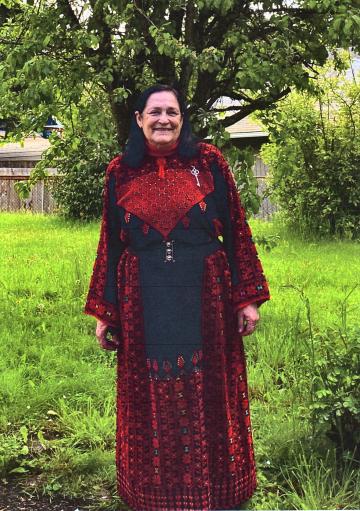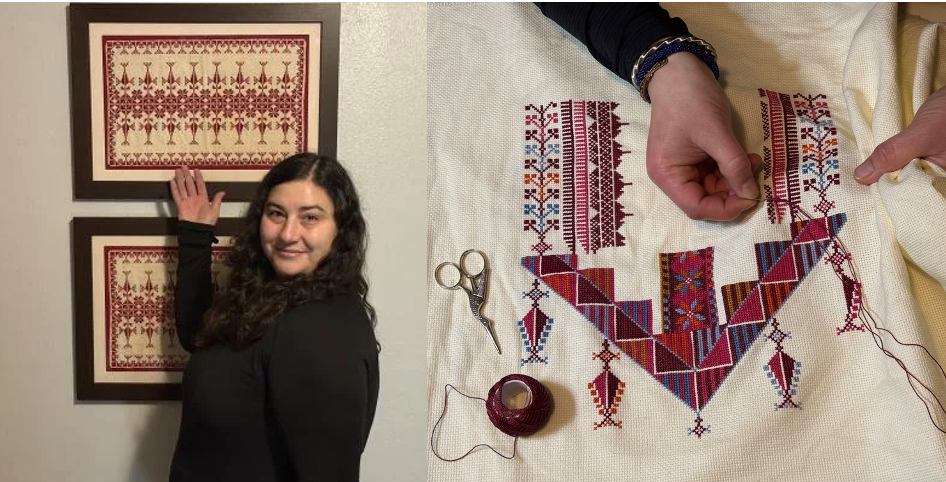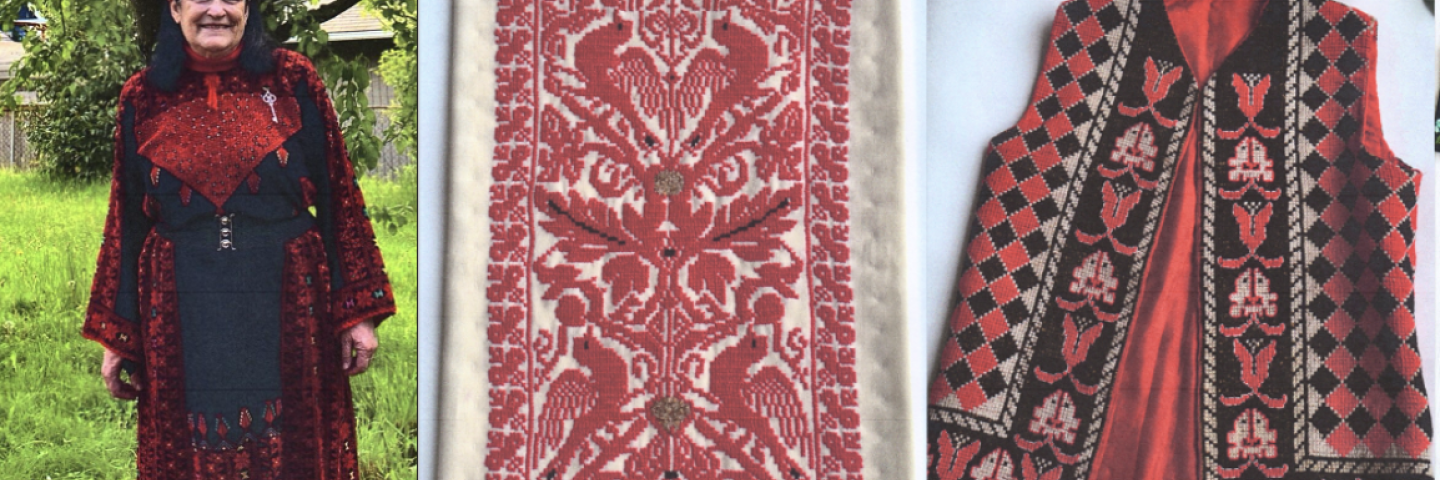ARTIST BIOGRAPHY
 | Traditional Skill/Art: Palestinian Embroidery Years Won: 2012, 2014, 2017, 2025 Website: feryalabbasighnaim.wordpress.com |
Abbasi-Ghnaim was born in the city of Safad in northern Palestine. Her family fled during the war when Israel was established in 1948, first to Syria then to Jordan as refugees. Abbasi-Ghnaim went to a boarding school in Ramallah and then returned to Syria to attend Damascus University as an Art History major. In 1980, she immigrated to the United States, where she worked in non-profit organizations that focused on cultural traditions, folk art, and oral history. She has lectured and taught about Palestinian traditions at the University of Massachusetts, the Oral History Center of Cambridge, Portland State University, and Lewis and Clark College, to name a few. She worked collaboratively with the World Affairs Council of Oregon and the Middle East Studies Center to participate in the “Teach the Middle East” forum, which was a workshop designed for youth. She also spent 15 years offering workshops and classes at all educational levels in public schools, in Beaverton, Milwaukie, Gresham, and Portland. In 2018, Abbasi-Ghnaim was honored with a lifetime achievement award as a master folk artist --- the National Endowment for the Arts: National Heritage Fellowship.
Abbasi-Ghnaim is married with three daughters and four grandchildren.
APPRENTICE BIOGRAPHY
 | Jenan Bisharat Traditional Skill/Art: Palestinian Embroidery Years Won: 2025 |
Bisharat is a first generation Palestinian-American whose Palestinian family is originally from the village of Ma’Alool in northern Galilee, Palestine, which was destroyed in 1948. During her childhood, she was exposed to her Palestinian cultural traditions, including Palestinian clothing, head coverings, embroidery, and decorative textiles. She fondly recalls her Tata (grandmother) wearing a head-scarf (Mandeel or Shunber) of muslin with block-printed floral patterns, and tatted edgings she made using a shuttle tool (Makook).
Bisharat has a B.A. in Art, studying pattern-making and garment construction, sewing, textile and fiber arts. She has four years of experience practicing Palestinian traditional embroidery/Tatreez, plus learning from books written by diverse generations of authors on the traditions, community engagement, online tutorials and hands-on learning. She also holds an A.A.S. Degree in Technology and currently works in community healthcare.
Expanding her knowledge and development of this traditional art form will be enormously transformative for her and others in the Palestinian community and in other communities as well. The experience and skills gained through this apprenticeship will play a vital role in preserving these techniques, the cultural significance and its impact on future generations.
Q&A WITH THE MENTOR ARTIST
Palestinian embroidery has a long history back to thousands of years. Women documented their lives through this art, telling stories about history, political events, geography, and nature. Through their embroidery, they taught younger generations lessons about the beauty and hazards of their surroundings; they also sent messages to each other through their embroidery (using needle and thread) when reading and writing were not available. I started learning embroidery at the age of the seven years old from my mother and grandmother and the women around me, as well as learning the stories behind the embroidery.
Embroidery is the unwritten language of transferring stories from woman to woman in silence. Needle and thread are the tools of documenting the history of their lives. For thousands of years, Palestinian women have stitched their cultural observations and traditions into patterns that represent everything from beauty to significant historical events and personages. The stories behind the patterns, the colors of the thread and the fashion of traditional Palestinian dress are just as important as learning the cross-stitch and is something that can only be preserved through teaching and mentoring the younger generations. Palestinian embroidery is an endangered art, that over the last three generations we have already lost its memory in our social traditions, instead surfacing stories of war and occupation as well as the redefinition of Palestinian identity through biculturalism.
It was very hard for other women to teach their daughters the art considering the Palestinian lives in exile. I carry a mission to help young Palestinians to learn it starting with my own daughters.
2018 National Endowment for the Arts National Heritage Fellow
Traditional Arts Apprenticeship Program Award (2012, 2014, 2017, 2025)
Oregon Folklife Program Apprenticeship Award (1993, 1995)
Massachusetts Folk Art Award (1985, 1986)
To see a full list of Abbasi-Ghnaim's awards and honors, visit
https://feryalabbasighnaim.wordpress.com/chronology/
Visit OFN's Culture Keepers Roster to learn more about the artist.
Traditional Arts Apprenticeship Program
More OFN programs
OFN main page
